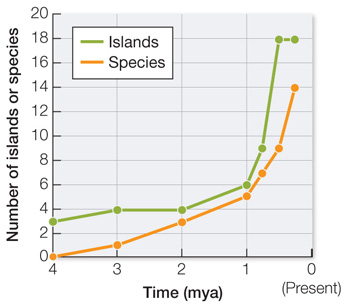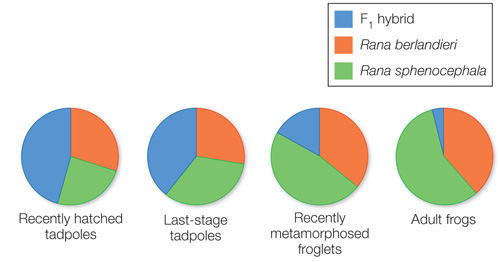Chapter 22
RECAP 22.1
Biologists are interested in many aspects of species, and their emphases differ depending on the questions they are asking about species. Biologists who are interested in the processes that led to lineage-
splitting emphasize the mechanisms that allow lineages to diverge and to remain isolated from one another after divergence (i.e., how species come into existence and remain distinct from one another). Biologists who are mostly concerned with identifying species and understanding their distribution in time and space are more likely to emphasize historical aspects and how we can tell species apart (i.e., how we recognize species in nature). Still other biologists may be interested primarily in how species co- exist in communities, and these biologists are likely to emphasize the ecological role of species (how do species differ in their adaptations and niches?). Each of these emphases leads different biologists to emphasize different attributes of species. Sexual lineages must have a substantial degree of reproductive isolation or they cannot remain distinct from one another. So even if a biologist is primarily using a morphological species concept, the morphological differences between species cannot be maintained in time and space unless the two species are largely reproductively isolated from each other. Obviously, reproductive isolation is central to the biological species concept. The many versions of lineage species concepts conceptualize species as distinct lineages in the tree of life. If these lineages are to remain distinct from one another through time, they must be substantially reproductively isolated from one another. Thus, reproductive isolation is important (either directly or indirectly) to all of the various species concepts.
The biological species concept limits its scope to “actually or potentially interbreeding natural populations.” Clearly, asexual organisms do not form such populations. Nonetheless, they do form lineages that exist in time and space, and these lineages may be maintained by other factors, such as available niche space. Most biologists who emphasize the biological species concept are interested primarily in the mechanisms that lead to reproductive isolation and its maintenance over time. The lineage concepts of species are not in conflict with the biological species concept, but they represent a more inclusive way to think about all species, regardless of their sexuality. The lineage concepts also allow biologists to study species across geological time (where reproductive interactions are not possible).
RECAP 22.2
If the only difference between the diverging lineages is at a single locus, then both of the new alleles must be functional when they interact with the products of other gene loci (in both lineages). Any genetic incompatibility produced by these new alleles would be expected to affect the parental lineages as well. There are much greater numbers of possible incompatibilities across different gene loci. Rather than two deleterious changes at the same locus (one in each lineage), the Dobzhansky–
Muller model allows neutral changes at any pair of loci whose products interact. It is the negative interaction of these products in the hybrid between the two lineages that results in genetic incompatibility. A-
23 Segregation doesn’t occur normally, because chromosome arms are linked differently on the different species, resulting in duplications and deletions in meiosis. If two different fusions of chromosomes occur in two different lineages, then the resulting chromosomes cannot pair normally in meiosis in the hybrids. If you attempt to diagram meiosis in the hybrid that would result from a cross of the divergent lineages in Figure 22.4 (see below), you will see that homologous pairings require parts of different chromosomes to align with one another. These chromosomes will then be pulled in two different directions as the cell divides in meiosis I, resulting either in a likely failure of the cell to divide or in an uneven distribution of the chromosome arms in the two daughter cells. Production of normal cells with an even distribution of the various chromosomes’ arms is impossible, so the hybrid organisms will not produce functional gametes.

A likely possibility is that the incompatible alleles have not yet become fixed in the various strains, so only some combinations of crosses result in genetic incompatibility.
RECAP 22.3
Polyploids (e.g., tetraploids) can be produced in the first generation. Hybrids between diploids and tetraploids may be produced in the second generation, forming triploid individuals, but meiosis in the triploids results in gametes with unbalanced chromosome numbers, which results in sterile offspring. An F1 tetraploid is able to self-
fertilize or mate with another tetraploid and produce fertile offspring. Thus, the polyploidy organism is reproductively isolated from the diploid species, making it a different species. Species that arise in allopatry initially occur in separate, but usually adjacent, ranges (e.g., see Figure 22.6). Therefore, we would expect many closely related species to exhibit this same pattern. The ranges of highly mobile species are more likely to change over time, so the pattern should be strongest among relatively sedentary species. Biologists have confirmed these predictions across many diverse groups of organisms.

Yes, because the curve for the number of species lags behind the curve for the number of islands; but the two curves exhibit very similar changes in slope through time. As new islands arise, new opportunities for speciation also arise. The number of species at any one time is always just below the number of distinct islands.
There are currently 18 islands in the archipelago and only 14 species (as recognized by some biologists). This suggests that there are still opportunities for additional speciation by geographic isolation. Based on our graph from question 3a, we expect populations of species that occur on two or more islands to diverge into distinct species over time. To test this hypothesis, we could collect samples of each population and examine genetic divergence between the samples. Significant genetic divergence between the populations on different islands suggests that the distance between the islands is a significant barrier to gene flow, so the populations are expected to diverge into distinct species over time (see Key Concept 22.2). Indeed, as we noted in the text discussing Darwin’s finches, some biologists recognize the genetically divergent (but morphologically similar) species on different islands as distinct species, which is why they recognize as many as 18 different species of Darwin’s finches.)
RECAP 22.4

Hybrids represent a smaller proportion of the samples at each successive life stage, indicating lower hybrid survivorship compared to either parental type. Postzygotic isolating mechanisms that are consistent with this pattern include low hybrid zygote viability and (for the adult frogs) low hybrid adult viability.
Selection against hybridization would favor non-
overlapping breeding seasons between the two species. Over time, more individuals that result from offset breeding seasons would be expected to survive (since no hybrids are produced in these cases). Assuming there is a genetic component that influences when a frog will breed, the populations would be expected to shift to produce non- overlapping breeding seasons (as seen in allopatric versus sympatric populations of these two species; see Figure 22.11). As overlap between breeding seasons is reduced, we would expect to see fewer hybrids at every life stage.
There are many possible designs of experiments that might prove informative. Here is an example of one that would examine the effect of flower position on pollinator attraction: Take one species of flower and divide the flowers into two groups. Position each flower to be either upright or pendant, then record the number and type of pollinators that are attracted to flowers in each group. Test to see if the differences between the two groups are statistically significant.
There is gene flow into the hybrid zone, but the hybrid zone acts as a “genetic sink.” The hybrids are less fit compared to either parental type, so there is little gene flow out of the hybrid zone. An expanding hybrid zone would require hybrids to move out of the hybrid zone and compete successfully against individuals of each of the two parental species.
RECAP 22.5
If a pollinator specializes on one particular flower type, that will reduce opportunities for cross-
fertilization among different flower types. Any polymorphism in flowers can thus lead to rapid genetic divergence between individuals that express each flower type. A similar process occurs with sexual selection in animals. If some females prefer to mate with males that have a certain trait and other females prefer a different male trait, then the population can quickly lead to genetic isolation and differentiation in the two groups. A new immigrant to an isolated area may encounter no competition for a particular feeding strategy or life style. Under these conditions, there are many “open niches” that can be co-
opted by the invading species, leading to a rapid increase in speciation.
WORK WITH THE DATA, P 479
For red flowers, the proportion of seeds from hybrid matings is 0.1298 (27/208). The 95% confidence limits of this proportion are approximately 0.09–
0.18. For pink flowers, the proportion of seeds from hybrid matings is 0.3813 (53/139). The 95% confidence limits of this proportion are approximately 0.30–
0.47. The null hypothesis is that there is no significant difference in the proportion of hybrid seeds produced from red versus pink flowers. This hypothesis is rejected; the probability that the null hypothesis is true is P < 0.0002.
Scientific studies often raise new questions that can be addressed by follow-
up experiments. Repeating this study in several different sites of sympatry and allopatry would address the unlikely possibility that red flowers are favored at the study site because of local conditions that have nothing to do with the presence of P. cuspidata (such as the local abundance of pollinators that prefer red flowers). A possible control experiment would involve removing all P. cuspidata from an area of sympatry and testing to see if the absence of P. cuspidata eliminates the selective advantage of red- flowered P. drummondii.
FIGURE QUESTIONS
Figure 22.5 Genetically distant pairs of species almost always develop Dobzhansky–
Figure 22.6 The glaciers eliminated most of the highlands that formerly connected the two areas, so there is now little appropriate habitat that would allow the differentiated species to interact. But if the interactions were possible, it is likely that the hybrids would exhibit reduced fitness (as explained by the Dobzhansky–
A-
Figure 22.11 Overlap in breeding seasons in areas of sympatry results in increased hybridization. The hybrids have reduced fitness, so there is selection in favor of frogs that breed at times when hybridization is less likely.
APPLY WHAT YOU’VE LEARNED
Hydrocarbon 2 shows a pattern consistent with reinforcement. Under reinforcement, the difference between the sympatric populations and the other species should be greater than the difference between the allopatric populations and the other species. This pattern is observed only for hydrocarbon 2.
Hydrocarbon 2 in the allopatric populations of D. serrata would be expected to evolve to be more like the sympatric populations and less like D. birchii. Thus, its concentration would be expected to decrease in the lab populations. The concentrations of the other hydrocarbons would be expected to remain about the same, as they do not appear to be undergoing reinforcement.
The frequency of hybridization should decrease. The artificial selection is operating on the hydrocarbon because hybridization with the other species is disfavored. As a result, fewer hybridizations should take place.
The level of postzygotic reproductive isolation should not change, as postzygotic isolation generally does not evolve via direct selection.